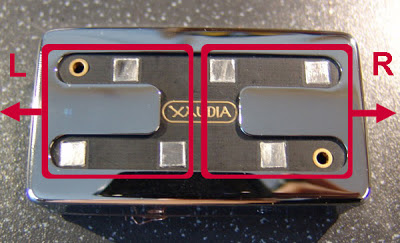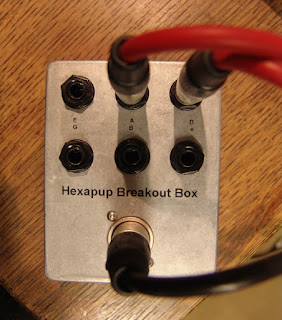Here are some wiring suggestions and sound samples for our ‘Hexapup’ hexaphonic pickups
Installation – Mounting the pickup
The hexapup is a standard humbucker size and will fit into most humbucker routed guitars without modification. Please note that the hexapup gives best results in the bridge position, and because it uses strong magnets it not really suitable for use as a neck pickup.
1. Mono pickup
When wired as a conventional mono pickup, the hexapup has a bright single coil tone. The coil arrangement means that it has very good hum rejection (humbucking) properties.
2. Stereo guitar.
The simplest way to connect the hexapup for stereo use is to mount two jack sockets into the guitar, and wire one side of the pickup to each jack. The signal can then be run to two amps or DI boxes for gigging or recording. There are two obvious ways to divide the strings, the pickup can be supplied in either split or spread mode, with spread being the default.
 |
| Split mode – low strings are sent to one amp, high strings to the other |
Split mode sends the low strings E, A and D to one channel, and the high strings G, B & e to the other, like Neil Young’s stereo guitar. Spread sends alternating strings to each channel, that is E, D and B to one output, and A, G & high-E to the other, which gives a nice spread of frequencies across the stereo image.
Here are some sound samples of the pickup in split mode. As always the stereo image comes across better on headphones than laptop speakers!
 |
| Spread mode – alternating strings are routed to each channel |
Here is one of the riffs above in stereo ‘spread‘ mode.
In each case the playing is a single guitar, and the recording was made using the DI input of API A2D preamp into protools, processed using Amplitube amp modelling plug-in.
3. Mono / Stereo Jack
4. Stereo guitar with Split / Spread switch.
On request, the hexapup may be supplied pre-wired with a switch to choose either split or spread mode. Here is an easy way of switching between the modes.
The hexaphonic pickup can of course be supplied with six pairs of output wires, which gives a vast range of wiring possibilities. Probably the simplest way is to use a 6 or 7 pin XLR socket for the guitar output, and run this to a breakout box wired to give six separate jacks.
 |
| Heavily modified Jagmaster with hexaphonic and stereo outputs. |
 |
| Six channel breakout box for a hexaphonic guitar. |
Here is a sample recording made in hexaphonic mode, with the EA strings panned left, the top B and E to the right, and the D and G strings lower in level and somewhere in the middle. Different amp models (Amplitube) have been used for left and right.
There are some further sound samples of the hexapup in full hexaphonic mode here.
Xaudia Hexapup – Typical specifications
Dimensions
Fits in a standard humbucker route.
70 mm x 39 mm x 20.5 mm deep (25 mm including screw lugs)
Stereo model (3 coils in series)
DC resistance = 5.1 K ohms
Inductance @ 1kHz = 0.9 Henry
Wiring = Red & black, green & white.
Case ground = green/yellow
Red & green = positive, black & white = negative
Hexaphonic model (single coil)
DC resistance = 1.8 K ohms per coil
Inductance @ 1kHz = 0.31 Henry per coil

